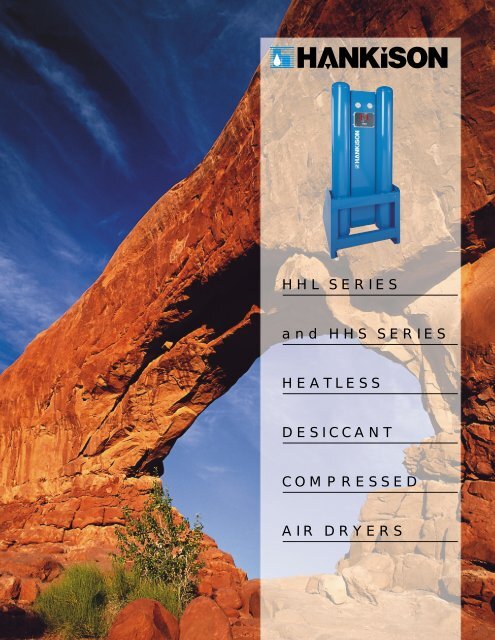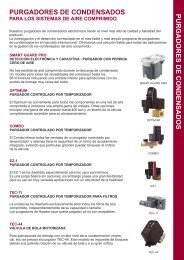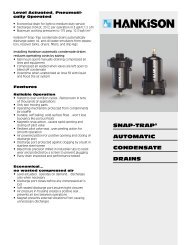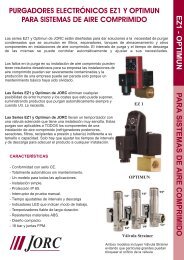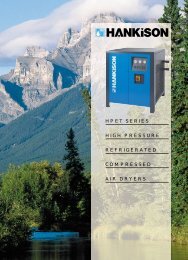Secador Disecante - HHL Serie.pdf - remco srl
Secador Disecante - HHL Serie.pdf - remco srl
Secador Disecante - HHL Serie.pdf - remco srl
Create successful ePaper yourself
Turn your PDF publications into a flip-book with our unique Google optimized e-Paper software.
<strong>HHL</strong> SERIES<br />
and HHS SERIES<br />
HEATLESS<br />
DESICCANT<br />
COMPRESSED<br />
AIR DRYERS
Hankison <strong>HHL</strong> and HHS <strong>Serie</strong>s Heatless<br />
Desiccant Dryers<br />
Sensitive applications requiring clean, dry,<br />
compressed air have turned to Hankison<br />
International since 1948. Utilizing twin towers with<br />
energy-efficient controls and the unique SensaSorb<br />
adsorbant, Hankison heatless desiccant dryers<br />
provide consistent outlet pressure dew points to<br />
-100°F (-73°C).<br />
Consistent Outlet Pressure<br />
Dew Points: Industry-leading<br />
Desiccant Beds<br />
• Unique SensaSorb desiccant beads with 3.0 mm diameter size<br />
(vs industry standard 3.2 mm) offer enhanced surface area and<br />
high crush strength which prolongs bed life<br />
• Large SensaSorb desiccant beds ensure 4.8 seconds of contact<br />
time…..allows wet, saturated air at the dryer inlet to be dried to<br />
the required dew point.<br />
• 30% extra desiccant provided to compensate for natural bed<br />
aging….ensures top performance over expected 3 to 5 years<br />
of SensaSorb desiccant bed life.<br />
• Large flow diffusers ensure even flow distribution through the<br />
bed and eliminate channeling<br />
• Towers are sized so that air velocity through the bed won’t<br />
fluidize the SensaSorb desiccant which prevents bed<br />
movement and desiccant dusting<br />
• Up-flow drying allows water and heavy contaminants to drop<br />
out of the air stream as they enter a tower which protects the<br />
bed from contamination. This makes it simple to discharge the<br />
contaminants when the tower depressurizes<br />
• Cleanable stainless steel flow diffusers/support screens and<br />
separate fill and drain ports for ease<br />
of SensaSorb desiccant replacement<br />
Four Dew Point Options per ISO 8573.1 Air Quality<br />
Standards<br />
Safety Built to Code<br />
Specifying a pressure dew point is not simple work for an engineer. <strong>HHL</strong> and HHS <strong>Serie</strong>s<br />
• Pressure vessels are CRN and ASME<br />
dryer designs are optimized to match four pressure dew point classes of the ISO 8573.1 Air<br />
Certified. Models above 60 scfm are<br />
Quality Standard.<br />
ASME stamped<br />
• Heavy-duty mufflers for quiet Table 1: Select your Dew Point per ISO 8573.1 Quality Classes<br />
operation-dryers are shipped with<br />
Remaining<br />
Cycle Time & Mode<br />
ISO 8573.1 Dew Moisture ** <strong>HHL</strong> HHS <strong>Serie</strong>s***<br />
an extra set of mufflers<br />
Class Point ppmw mg/m 3 <strong>Serie</strong>s Energy Savings<br />
• NEMA 4 electrical construction<br />
1 -100°F (-73°C)* 0.12 0.15 4 min. fixed --<br />
is standard<br />
2 -40°F (-40°C) 10 12 10 min. fixed Demand<br />
• Pressure relief valves are standard<br />
3 -4°F (-20°C) 81 97 16 min. fixed Demand<br />
4 +38°F (+3°C) 610 730 24 min. fixed Demand<br />
* This performance exceeds Quality Class 1 set at -94°F (-70°C)<br />
** At 100 psig (7 bar)<br />
*** The HHS <strong>Serie</strong>s controller also offers fixed cycle settings<br />
2
<strong>HHL</strong>/HHS <strong>Serie</strong>s<br />
Space-Saving Design<br />
Models 40-450 scfm<br />
Microelectronics, food packaging, paper, glass, pharmaceutical, powder<br />
painting, hospital laboratories: these industries are a small representative<br />
sample of industries utilizing desiccant dryers. They all have one thing in<br />
common….they need to save space on the factory/laboratory floor.<br />
Space-saving Integrated Filtration<br />
• Pre-filter and after-filter packages featuring Hankison HF <strong>Serie</strong>s coalescing filters are<br />
pre-installed on custom brackets within the dryer’s footprint – requiring no additional<br />
floor space<br />
• HF <strong>Serie</strong>s Grade 9 (3 micron bulk liquid) and Grade 5 (0.008 ppm oil aerosols) pre-filters<br />
are recommended for –40°F to +38°F (-40°C to +3°C) dew points<br />
• HF <strong>Serie</strong>s Grade 7 (1 micron particulate) and Grade 3 (0.0008 ppm oil aerosols) prefilters<br />
are recommended for –100°F (-73°C) dew points<br />
• HF <strong>Serie</strong>s Grade 6 (1 micron dry particulate) and Grade 1 (oil vapor) are the<br />
recommended after-filters<br />
• Standard pilot air filter and regulator<br />
Space-saving Piping<br />
• Height of the dryer has been minimized which allows for easier access to upper-floor<br />
hospital laboratories and other hard to access areas.<br />
• Achieved by placing the inlet and outlet process flow nozzles in the back of the vessels<br />
rather than through the top and bottom.<br />
Standard Instrumentation<br />
Accurate and<br />
Durable Valves<br />
• Inlet switching valves are normally open,<br />
pneumatically piston actuated, Y-angle<br />
poppet valves<br />
• Purge/repressurization valves are<br />
normally closed, pneumatically piston<br />
actuated, Y-angle poppet valves.<br />
• Three-way pilot solenoid valves are wired<br />
to the controller and used to direct pilot<br />
air to the actuators of the inlet switching<br />
and purge/repressurization valves<br />
• Outlet shuttle valve tested to 1 million<br />
cycles with tough desiccant dust<br />
challenge<br />
• Purge pressure adjustment valve<br />
• Left and right tower pressure gauges<br />
• Purge pressure gauge<br />
• Moisture indicator – alerts operator of elevated dew point<br />
• <strong>HHL</strong> <strong>Serie</strong>s or HHS <strong>Serie</strong>s electronic control panel<br />
3
<strong>HHL</strong>/HHS <strong>Serie</strong>s Reliability for Large Applications<br />
Models 590-5400 scfm<br />
Premium Quality Valves<br />
• Premium quality inlet switching and<br />
purge/repressurization valves. Air operated<br />
butterfly valves and dual piston, double acting<br />
rack and pinion actuators. Actuators are<br />
isolated from the air stream and cannot be<br />
contaminated by incoming moisture.<br />
• Purge/repressurization valves include a spring<br />
assist to hold them closed prior to start-up<br />
and upon loss of pressure-protects desiccant<br />
bed from outside contamination and allows<br />
easy start-up.<br />
• Single solenoid, four-way pilot valves are wired<br />
to the controller and used to direct pilot air to the actuators<br />
of the inlet switching and purge/repressurization valves.<br />
• Check valves are soft seated for sure closure and minimal<br />
wear. Two mainline outlet and two smaller purge line check<br />
valves control the flow of outlet and purge air.<br />
• Throttling globe valve provides highly accurate purge<br />
pressure adjustment.<br />
Standard Instrumentation<br />
• Left and right tower pressure gauges.<br />
• Purge pressure gauge.<br />
• Moisture indicator – alerts operator of elevated dew point.<br />
• Standard pilot air filter and regulator.<br />
• <strong>HHL</strong> <strong>Serie</strong>s or HHS <strong>Serie</strong>s electronic control panel.<br />
Filtration Packages with By-pass Piping<br />
Pre-filter and after-filter packages<br />
featuring Hankison HF <strong>Serie</strong>s coalescing<br />
filters can be assembled in many different<br />
by-pass arrangements. Basic<br />
packages include:<br />
4
HHS <strong>Serie</strong>s with Sensatherm ®<br />
Energy Savings<br />
Models 40-5400 scfm<br />
Sensatherm ®<br />
Energy Savings<br />
• Minimizes purge air usage<br />
when operating at<br />
reduced loads<br />
• Automatically matches<br />
purge air use to the<br />
demand on the system<br />
At full load, a tower contains<br />
five minutes of drying<br />
capacity.<br />
At less than full load, the<br />
amount of purge air used may<br />
be minimized by keeping a<br />
tower on-line until its full<br />
drying capacity is utilized.<br />
For example, at 50% of load a<br />
tower is able to stay on-line<br />
for 10 minutes (instead of the<br />
usual 5) at 33% of load, it is<br />
able to stay on-line for 15<br />
minutes. By doing this, purge<br />
air use is matched to the<br />
demand on the system - at<br />
50% of load, 50% of the<br />
normal purge air is used; at<br />
33% of load, 33% of<br />
the normal purge air is used.<br />
Hankison’s patented<br />
Sensatherm ® purge saving<br />
system matches purge air use<br />
to the demand on the dryer<br />
by monitoring the changes in<br />
temperature within the<br />
desiccant beds. These changes<br />
are the result of heat that is<br />
released during the drying<br />
stage (heat of adsorption) and<br />
re-adsorbed during the<br />
regeneration stage. The<br />
degree of temperature<br />
change is an indirect measure<br />
of the water vapor content in<br />
the compressed air system<br />
and is used to determine the<br />
time a tower stays on-line<br />
during the drying stage.<br />
Advantages:<br />
1. Temperature transducers (thermistors) are used as<br />
sensing devices - they are simpler, more reliable, and<br />
more rugged than the humidity, pressure, and flow<br />
transducers used by others.<br />
2. Sensors used on the Sensatherm ® system require<br />
no calibration.<br />
3. The system is based on saving the heat of adsorption -<br />
towers switch before heat is lost... maximizing purge<br />
air efficiency and minimizing the amount of purge<br />
air required.<br />
Sensatherm ® Operation<br />
As Tower 4B goes off-line and begins the regeneration<br />
stage, sensor B1 takes a temperature reading. At the end<br />
of the regeneration stage, sensor B1 takes another<br />
reading. The Sensatherm’s microprocessor uses this<br />
temperature difference to calculate the temperature rise<br />
that will occur during the drying stage as the bed becomes<br />
fully loaded. When Tower 4B returns to the drying stage,<br />
sensor B2 takes a reading and begins monitoring the<br />
temperature rise. When the calculated temperature rise<br />
occurs, indicating that the bed is fully loaded, the<br />
processor signals the tower to go off-line for regeneration.<br />
HHS <strong>Serie</strong>s Controller Features:<br />
• Choice of four operating modes<br />
(see page 2 for ISO dew point classes)<br />
• Sensatherm Demand mode<br />
• Switches for On/Off, Alarm and Service<br />
reminder reset<br />
• Operational LED lights for<br />
power-on, tower status, valve<br />
status, and tower pressure<br />
• Service reminder LED lights for<br />
filters and drains, valves, and<br />
desiccant. The user selects<br />
between a Normal and a<br />
Severe service interval<br />
• Alarm LED for tower switching<br />
failure, filter monitor signals,<br />
electronic demand drain<br />
alarms on filters<br />
RS232<br />
• Vacuum fluorescent text display communicates<br />
energy savings, operating mode and service<br />
reminders<br />
• RS-232 communications port is standard.<br />
WebAirNet Internet Remote Monitoring is optional<br />
P 1<br />
P 3<br />
P 2<br />
5
<strong>HHL</strong> <strong>Serie</strong>s with Purge Economizer<br />
Energy Savings<br />
Models 40-5400 scfm<br />
Purge<br />
Economizer<br />
Energy Savings<br />
Reducing the amount of time<br />
the dryer spends purging in<br />
the regeneration cycle can<br />
save energy. Eight settings (0%<br />
to 70% in 10% increments) are<br />
furnished to allow end users to<br />
reduce the purge to match<br />
reduced air loads on the dryer.<br />
Each energy saving setting has<br />
an LED which will illuminate<br />
when it is selected. Simply use<br />
the supplied switch to select<br />
the desired energy saving<br />
setting.<br />
<strong>HHL</strong> Controller Features:<br />
• Choice of four fixed cycle<br />
operating modes corresponding<br />
to ISO 8573.1 Air Quality Classes<br />
(see page 2 for ISO dew point<br />
classes and cycle times)<br />
• Choice of eight Purge Economizer<br />
Energy Savings settings with an<br />
energy saving selector switch<br />
• Switches for ISO Class dew point,<br />
On/Off, Alarm and Service<br />
reminder reset<br />
• Operational LED lights for poweron,<br />
tower status, valve status, and<br />
tower pressure<br />
• Service reminder LED lights for<br />
filters and drains, valves, and<br />
desiccant. The user selects<br />
between a Normal and a Severe<br />
service interval<br />
RS232<br />
• Alarm LED for valve switching failure<br />
P1<br />
P 1<br />
P 3<br />
P 2<br />
• RS-232 communications port is standard. WebAirNet<br />
Internet Remote Monitoring is optional<br />
P2<br />
ISO 8573.1<br />
Class<br />
1 -100°F / -73°C<br />
2 -40°F / -40°C<br />
3 -4°F / -20°C<br />
4 +38°F / +3°C<br />
P3<br />
kW<br />
70%<br />
60<br />
50<br />
40<br />
30<br />
20<br />
10<br />
0%<br />
P4<br />
<strong>HHL</strong>/HHS <strong>Serie</strong>s<br />
Engineered-to-Order<br />
Options<br />
• Cabinet enclosures for dryers and filters<br />
with front panel-mounted Filter<br />
Monitors which communicate pre- and<br />
after-filter performance<br />
• High dew point alarm which includes<br />
light and voltage free contacts for<br />
remote alarm<br />
• Dew point monitor which includes<br />
digital display, voltage-free contacts and<br />
recorder output<br />
• Low ambient packages, epoxy paint,<br />
severe environment protection<br />
• Higher pressures to 1500 psig (103 bar)<br />
• Oil-free packages with integrated<br />
activated carbon towers<br />
6
<strong>HHL</strong> & HHS <strong>Serie</strong>s Specifications<br />
Table 1<br />
Inlet Flow @<br />
Dimensions (in)<br />
Model 100 psig (7 bar) Connections (1) Weight<br />
scfm Height Width Depth (lbs)<br />
<strong>HHL</strong>/HHS-40 40 74 26 26 1/2” NPT 365<br />
<strong>HHL</strong>/HHS-60 60 76 26 26 3/4” NPT 445<br />
<strong>HHL</strong>/HHS-90 90 76 33 33 3/4” NPT 575<br />
<strong>HHL</strong>/HHS-115 115 76 33 33 1” NPT 685<br />
<strong>HHL</strong>/HHS-165 165 76 33 33 1” NPT 685<br />
<strong>HHL</strong>/HHS-260 260 80 44 44 1-1/2” NPT 1010<br />
<strong>HHL</strong>/HHS-370 370 81 44 44 1-1/2” NPT 1215<br />
<strong>HHL</strong>/HHS-450 450 82 44 44 1-1/2” NPT 1350<br />
<strong>HHL</strong>/HHS-590 590 95 52 48 2” NPT 2205<br />
<strong>HHL</strong>/HHS-750 750 97 52 48 2-1/2” NPT 2705<br />
<strong>HHL</strong>/HHS-930 930 102 58 56 2-1/2” NPT 3228<br />
<strong>HHL</strong>/HHS-1130 1130 104 62 57 3” ANSI Flg. 3740<br />
<strong>HHL</strong>/HHS-1350 1350 109 63 57 3” ANSI Flg. 4252<br />
<strong>HHL</strong>/HHS-1550 1550 109 77 68 4” ANSI Flg. 4796<br />
<strong>HHL</strong>/HHS-2100 2100 106 85 75 4” ANSI Flg. 5100<br />
<strong>HHL</strong>/HHS-3000 3000 121 80 89 6” ANSI Flg. 8500<br />
<strong>HHL</strong>/HHS-4100 4100 105 91 85 6” ANSI Flg. 9900<br />
<strong>HHL</strong>/HHS-5400 5400 122 102 92 6” ANSI Flg. 12,000<br />
Dimensions and weights are for reference only. Request certified drawings for construction purposes.<br />
(1) BSP and DIN flanges are available.<br />
Regeneration flow rate<br />
The amount of air used during the<br />
regeneration phase consists of the<br />
amount used while the<br />
purge/repressurization valve is open<br />
(purge air) plus the volume of air used to<br />
repressurize the tower after the<br />
purge/repressurization valve closes.<br />
Typically the rate shown is averaged over<br />
the cycle time. At 100 psig (7 bar),<br />
average air use is 14.4% of the inlet flow<br />
capacity (13.7% for purge +0.7% for<br />
repressurization) for dryers operating on<br />
a 10 minute cycle; 15.5% (13.7% for purge<br />
+1.8% for repressurization) for dryers<br />
operating on a 4 minute cycle.<br />
Instantaneous flow rate (air flowing while<br />
the purge/repressurization valve is open)<br />
varies with cycle selection, Energy Savings<br />
setting, and inlet pressure.<br />
Inlet flows<br />
Inlet flow capacities are established in<br />
accordance with CAGI (Compressed Air<br />
and Gas Institute) standard ADF-200: Inlet<br />
air pressure 100 psig (7 bar), inlet<br />
temperature saturated at 100°F (38°C). To<br />
determine inlet flow at pressures other<br />
than 100 psig (7 bar), multiply inlet flow at<br />
100 psig (7 bar) from Specifications<br />
Table 1 by the corresponding multiplier in<br />
Table 2.<br />
Electrics<br />
Available voltages:<br />
120 V/1 ph/60 Hz<br />
120 V/1 ph/50 Hz<br />
240 V/1 ph/60 Hz<br />
220 V/1 ph/50 Hz<br />
11.5-28 VDC<br />
NEMA 4 standard<br />
Maximum Working<br />
Pressure<br />
150 psig (10.5 bar) standard<br />
250 psig (17.6 bar) optional<br />
Units for higher maximum working<br />
pressures are available<br />
Minimum Operating<br />
Pressure<br />
For 150 psig (10.5 bar) models the<br />
minimum operating pressure:<br />
60 psig (4.2 bar)<br />
For 250 psig (17.6 bar) models the<br />
minimum operating pressure:<br />
120 psig (8.3 bar)<br />
For lower pressures contact factory<br />
Maximum inlet air<br />
or ambient air<br />
temperature:<br />
120°F (49°C)<br />
Table 2<br />
Operating<br />
Pressure<br />
Pressure drop at<br />
rated flow: less than<br />
5 psi (0.34 bar)<br />
psig 60 70 80 90 100 110 120 130 140 150 175 200 225 250<br />
bar 4.2 4.9 5.6 6.3 7.0 7.7 8.4 9.1 9.8 10.5 12.3 14.1 15.8 17.6<br />
Multiplier 0.65 0.74 0.83 0.91 1.00 1.04 1.08 1.12 1.16 1.20 1.29 1.37 1.45 1.52<br />
7
HIT <strong>Serie</strong>s<br />
Grade 5<br />
ISO 8573.1<br />
System ∆P*<br />
Air Quality Class<br />
Solids Moisture Oil psi bar<br />
3 6 5<br />
Body shops, sand blasting


